

It was constructed in 1867 for the Archduke Leopold Salvator of Austria. The architect is unknown; the facade may have been designed by Carl Tietz. The palace was up to four stories high, and was built in neo-classic style with elaborate figural decoration in its middle part. In the back part there was a large garden which extended all the way to that of the Palais Rothschild. The palace was slightly damaged during World War II. The descendants of the archduke could not afford the repair costs and sold the estate. The palace then was torn down. For decades the palace location was used as a parking lot by employees of the ORF public broadcasting company. Recently a nondescript modern building has been erected there. [1]
1 Address was at Argentinierstraße 29, in the IV. District Wieden

The Albertina is a museum in the Innere Stadt of Vienna, Austria. It houses one of the largest and most important print rooms in the world with approximately 65,000 drawings and approximately 1 million old master prints, as well as more modern graphic works, photographs and architectural drawings. Apart from the graphics collection the museum has recently acquired on permanent loan two significant collections of Impressionist and early 20th-century art, some of which will be on permanent display. The museum also houses temporary exhibitions. The museum had 360,073 visitors in 2020, down 64 percent from 2019 due to the COVID-19 pandemic, but still ranked 55th in the List of most-visited art museums in the world.

Palais Rothschild refers to a number of palaces in Vienna, Austria, which were owned by members of the Austrian branch of the Rothschild banking family. Apart from their sheer size and elegance, they were famous for the huge collections of valuable paintings, statues, furniture, books and armour that they housed, another reflection of the family's vast wealth and prominent position.

Palais Schwarzenberg is a Baroque palace in front of Schwarzenbergplatz, Landstraße, the 3rd district of Vienna, Austria. It is owned by the princely Schwarzenberg family.

Palais Augarten is a Baroque palace in the district of Leopoldstadt, Vienna, Austria. Constructed in the late seventeenth century by Johann Bernhard Fischer von Erlach on the site of a hunting château and gardens, the palace and gardens were expanded in the nineteenth century under Emperor Franz Joseph I of Austria. Despite extensive damage suffered during World War II, the palace has been maintained almost in its original appearance, and many of the original furnishings can still be found there. Today, Palais Augarten is the home and rehearsal space of the Vienna Boys' Choir, who also have their own school there. The palace is located in the 130-acre Augarten park, which is the oldest Baroque garden in Vienna.

Palais Lobkowitz, or Palais Dietrichstein-Lobkowitz, is a Baroque palace in Vienna, Austria. It was owned by the noble Lobkowitz family.
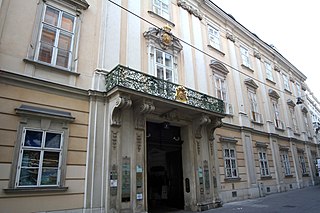
Palais Esterházy is a baroque palace in Vienna, Austria, owned by the noble Esterházy family. It houses a famous and popular restaurant in the former wine cellars, called Esterházykeller.
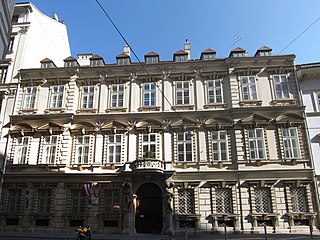
Palais Caprara-Geymüller, sometimes known as Palais Caprara, is a Baroque palace in Vienna, Austria. The Vienna Stock Exchange is situated in the palace.

Palais Pálffy is a palace located on Josefsplatz in the Innere Stadt district of Vienna, Austria. It was once owned by the noble Pálffy family.

Palais Pallavicini is a palace in Vienna, Austria. It is located in the Josefsplatz square at number 5. It has been owned by the noble Pallavicini family. It was previously built and owned by the Fries banking family and is therefore also known as Palais Fries.

Palais Kinsky is a Baroque palace in central Vienna, Austria. It was originally built for Count Wirich Philipp von Daun, the garrison commander whose son Leopold became a Field Marshal of Empress Maria Theresa. The palace was later bought by the Kinsky family of Bohemia, and it is sometimes called the Palais Daun-Kinsky.
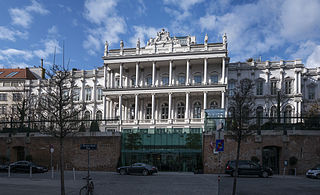
Palais Coburg, also known as Palais Saxe-Coburg, is a palace in Vienna, Austria. It was owned by the Kohary branch of the House of Saxe-Coburg and Gotha.
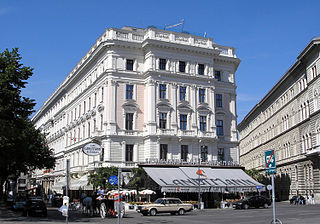
Palais Lieben-Auspitz is a Ringstraßenpalais in Vienna, Vienna, located in the city's Innere Stadt.

Palais Ephrussi is a former Ringstraßenpalais in Vienna. It was built for the Ephrussi family of financiers by Theophil Freiherr von Hansen, the architect of the Austrian Parliament Building. It is on the Ringstrasse, specifically the Universitätsring, opposite the Votivkirche.

Palais Epstein is a Ringstraßenpalais in Vienna, Austria. It was built for the industrialist and banker Gustav Ritter von Epstein. The architect was Theophil Freiherr von Hansen, who also designed the adjacent Austrian Parliament Building. Unlike traditional Baroque noble palaces in Vienna, Palais Epstein was built in the late 19th century and is therefore considered a Ringstraßenpalais. It is up to five storeys high and built in the neo-renaissance style typical of its time.
The Herrengasse is a street in Vienna, located in the first district Innere Stadt.

The Stallburg is a renaissance-style building in the Vienna city center located between Josefsplatz and Michaelerplatz. It is part of the Hofburg Palace.

The Max Reinhardt Seminar is the School of Drama at the University of Music and Performing Arts in Vienna, Austria. It is located in the Palais Cumberland, Penzingerstraße 9, in Vienna's 14th district.

The Weltmuseum Wien in Vienna is the largest anthropological museum in Austria, established in 1876. It currently resides in the Hofburg Imperial Palace and houses more than 400,000 ethnographical and archaeological objects from Asia, Africa, Oceania, and America. Since November 2014 the museum was closed due to renovation and was reopened on the 25th of October 2017.
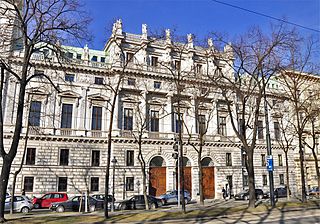
The Deutschmeister-Palais or Palais Erzherzog Wilhelm is a building in Vienna located at Parkring 8.

The Palais Erzherzog Ludwig Viktor is one of the best known Ringstraßenpalais in Vienna. It was built between 1863 and 1866. The first building to be built on the Schwarzenbergplatz, it is now a subsidiary house of the Burgtheater.
Coordinates: 48°11′41″N16°22′24″E / 48.1948°N 16.3734°E